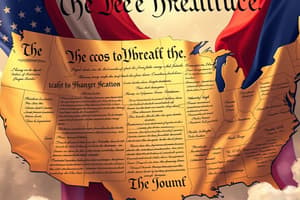Podcast
Questions and Answers
What is the primary purpose of the Preamble in the United States Constitution?
What is the primary purpose of the Preamble in the United States Constitution?
- To define the rights and protections granted by the Constitution
- To outline the process for amending the Constitution
- To establish the three branches of government
- To emphasize the importance of liberty, justice, and the rule of law (correct)
Which of the following is NOT one of the branches of government established by the Constitution?
Which of the following is NOT one of the branches of government established by the Constitution?
- Judicial branch
- Regulatory branch (correct)
- Legislative branch
- Executive branch
Which amendment to the Constitution granted voting rights to women?
Which amendment to the Constitution granted voting rights to women?
- 19th Amendment (correct)
- 13th Amendment
- 14th Amendment
- 15th Amendment
According to the Constitution, which branch of government is responsible for interpreting laws?
According to the Constitution, which branch of government is responsible for interpreting laws?
How many amendments have been ratified in total, including the Bill of Rights?
How many amendments have been ratified in total, including the Bill of Rights?
Which branch of the United States government is established by Article III of the Constitution?
Which branch of the United States government is established by Article III of the Constitution?
What does Article V of the United States Constitution primarily address?
What does Article V of the United States Constitution primarily address?
In the United States Constitution, which article ensures the supremacy of the Constitution and provides procedures for resolving disputes between federal and state governments?
In the United States Constitution, which article ensures the supremacy of the Constitution and provides procedures for resolving disputes between federal and state governments?
Which part of the United States Constitution allows for addressing changing societal needs?
Which part of the United States Constitution allows for addressing changing societal needs?
What is established by Article IV of the United States Constitution?
What is established by Article IV of the United States Constitution?
Study Notes
Understanding the United States Constitution
The United States Constitution, adopted in 1787, serves as the nation's foundational document, establishing our system of government and protecting individual rights. Let's explore four key aspects of the Constitution: the Articles, Amendments, Separation of Powers, and the Preamble.
Articles
The Constitution consists of seven Articles, each addressing a specific aspect of the United States government.
- Article I outlines the legislative branch, which consists of the House of Representatives and the Senate.
- Article II establishes the executive branch, led by the President.
- Article III establishes the judicial branch, including the Supreme Court.
- Article IV details the relationships between the states, including the full faith and credit clause and the privileges and immunities clause.
- Article V outlines the amendment process, which allows for future changes to the Constitution.
- Article VI ensures the supremacy of the Constitution and establishes procedures for resolving disputes between federal and state governments.
- Article VII provides for the ratification of the Constitution by state conventions.
Amendments
The United States Constitution allows for amendments to address changing societal needs. So far, 27 amendments have been ratified, including the Bill of Rights (the first ten amendments) and the 13th, 14th, 15th, 19th, and 26th Amendments, which granted rights and protections to various groups.
Separation of Powers
The Constitution's structure ensures that each branch of government serves as a check on the others, preventing any one branch from amassing too much power.
- The legislative branch makes laws, oversees taxes, and regulates interstate and foreign commerce.
- The executive branch enforces laws, conducts foreign relations, and commands the military.
- The judicial branch interprets the laws and provides a means for resolving disputes, including those between the government and citizens, and between the states.
Preamble
The Preamble provides the purpose and intent of the Constitution and stresses the importance of liberty, justice, and the rule of law. The Preamble begins with the famous line, "We the People of the United States," emphasizing the sovereignty of the American people and their role in establishing the Constitution.
In summary, the United States Constitution is a remarkable document that establishes our government and protects our rights. By understanding its key components and subtopics, we better appreciate the intricacies of our democracy and the principles on which it is founded.
Studying That Suits You
Use AI to generate personalized quizzes and flashcards to suit your learning preferences.
Description
Explore key aspects of the United States Constitution including the Articles, Amendments, Separation of Powers, and the Preamble. Learn about the structure of the government, the amendment process, the balance of powers among branches, and the principles outlined in the Preamble.




